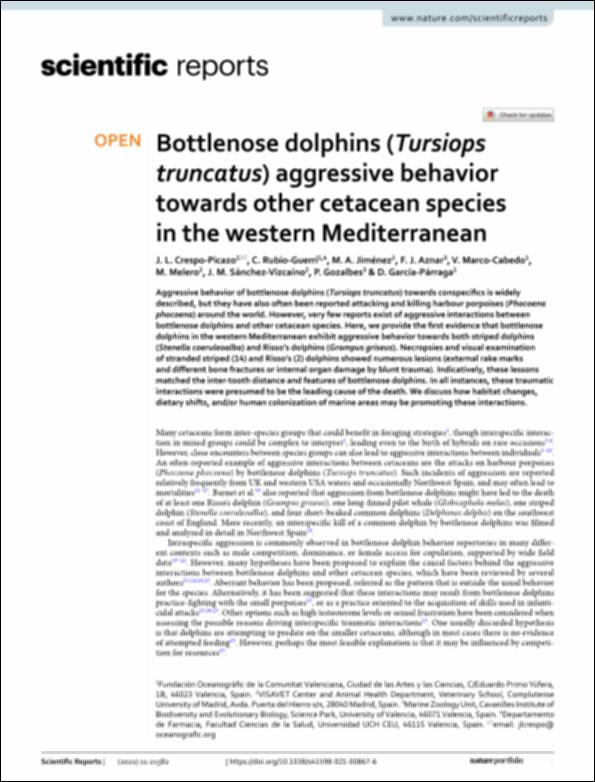Please use this identifier to cite or link to this item:
http://hdl.handle.net/10637/13994Bottlenose dolphins ("Tursiops truncatus") aggressive behavior towards other cetacean species in the Western Mediterranean
| Title: | Bottlenose dolphins ("Tursiops truncatus") aggressive behavior towards other cetacean species in the Western Mediterranean |
| Authors : | Crespo Picazo, José Luis Rubio Guerri, Consuelo Jiménez Martínez, María de los Ángeles Aznar Avendaño, Francisco Javier Marco Cabedo, Vicente Melero Asensio, Mar |
| Keywords: | Dental plaque - Diseases.; Ecología microbiana.; Mouth - Microbiology.; Dientes - Bacteriología.; Placa dental - Enfermedades.; Microbial ecology. |
| Publisher: | Springer Nature |
| Citation: | Crespo-Picazo, J.L., Rubio-Guerri, C., Jiménez, M.A., Aznar, F.J., Marco-Cabedo, V., Melero, M. et al. (2021). Bottlenose dolphins ("Tursiops truncatus") aggressive behavior towards other cetacean species in the Western Mediterranean. Scientific Reports, vol. 11, art. 21582 (03 nov.). DOI: https://doi.org/10.1038/s41598-021-00867-6 |
| Abstract: | Aggressive behavior of bottlenose dolphins (Tursiops truncatus) towards conspecifics is widely described, but they have also often been reported attacking and killing harbour porpoises (Phocoena phocoena) around the world. However, very few reports exist of aggressive interactions between bottlenose dolphins and other cetacean species. Here, we provide the first evidence that bottlenose dolphins in the western Mediterranean exhibit aggressive behavior towards both striped dolphins (Stenella coeruleoalba) and Risso’s dolphins (Grampus griseus). Necropsies and visual examination of stranded striped (14) and Risso’s (2) dolphins showed numerous lesions (external rake marks and different bone fractures or internal organ damage by blunt trauma). Indicatively, these lessons matched the inter-tooth distance and features of bottlenose dolphins. In all instances, these traumatic interactions were presumed to be the leading cause of the death. We discuss how habitat changes, dietary shifts, and/or human colonization of marine areas may be promoting these interactions. |
| Description: | En este artículo también participan los siguientes autores: J.M. Sánchez-Vizcaíno, P. Gozalbes y D. García-Párraga. Este artículo se encuentra disponible en la página web de la revista en la siguiente URL: https://www.nature.com/articles/s41598-021-00867-6 |
| URI: | http://hdl.handle.net/10637/13994 |
| Rights : | http://creativecommons.org/licenses/by/4.0/deed.es |
| ISSN: | 2045-2322 (Electrónico) |
| Issue Date: | 3-Nov-2021 |
| Center : | Universidad Cardenal Herrera-CEU |
| Appears in Collections: | Dpto. Farmacia |
Items in DSpace are protected by copyright, with all rights reserved, unless otherwise indicated.


